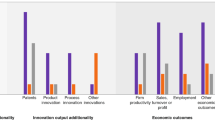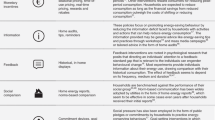Abstract
Cities are increasingly adopting energy policies that reduce information asymmetries and knowledge gaps through data transparency, including energy disclosure and mandatory audit requirements for existing buildings. Although such audits impose non-trivial costs on building owners, their energy use impacts have not been empirically evaluated. Here we examine the effect of a large-scale mandatory audit policy—New York City’s Local Law 87—on building energy use, using detailed audit and energy data between 2011 and 2016 for approximately 4,000 buildings. This specific policy context, in which the compliance year is randomly assigned, provides a unique opportunity to explore the audit effect without the self-selection bias found in studies of voluntary audit policies. We find energy use reductions of approximately –2.5% for multifamily residential buildings and –4.9% for office buildings. The results suggest that mandatory audits, by themselves, create an insufficient incentive to invest in energy efficiency at the scale needed to meet citywide carbon-reduction goals.
This is a preview of subscription content, access via your institution
Access options
Access Nature and 54 other Nature Portfolio journals
Get Nature+, our best-value online-access subscription
$29.99 / 30 days
cancel any time
Subscribe to this journal
Receive 12 digital issues and online access to articles
$119.00 per year
only $9.92 per issue
Buy this article
- Purchase on Springer Link
- Instant access to full article PDF
Prices may be subject to local taxes which are calculated during checkout



Similar content being viewed by others
Data availability
All data, except LL87 data, are available through the NYC Open Data Portal at https://opendata.cityofnewyork.us/. LL87 data are available upon reasonable request, and with permission, from the NYC Mayor’s Office of Sustainability. The data that support the plots within this Article and other findings of this study can be obtained from the NYC Mayor’s Office of Sustainability or the authors, upon permission from the NYC Mayor’s Office of Sustainability who own the data.
Code availability
Any applicable code relevant to the findings is available from the authors upon reasonable request.
References
Glaeser, E. L. & Kahn, M. E. The greenness of cities: carbon dioxide emissions and urban development. J. Urban Econ. 67, 404–418 (2010).
Inventory of New York City Greenhouse Gas Emissions (City of New York, 2017); https://www.dec.ny.gov/docs/administration_pdf/nycghg.pdf
Burr, A., Keicher, C. & Lawrence, J. Commercial Building Energy Rating and Disclosure Policies (Institute for Market Transformation, 2013).
Jaffe, A. B. & Stavins, R. N. The energy-efficiency gap What does it mean? Energy Policy 22, 804–810 (1994).
Map: U.S. City, County, and State Policies for Existing Buildings: Benchmarking, Transparency and Beyond (Institute for Market Transformation, 2017); https://www.imt.org/resources/map-u-s-building-benchmarking-policies
LL87: energy audits & retro-commissioning NYC Mayor’s Office of Sustainability http://www.nyc.gov/html/gbee/html/plan/ll87.shtml (2020).
New York City’s Energy and Water Use 2014 and 2015 Report (City of New York, 2017); http://www.nyc.gov/html/gbee/downloads/pdf/UGC-Benchmarking-Report-101617-FINAL.pdf
Meng, T., Hsu, D. & Han, A. Estimating energy savings from benchmarking policies in New York City. Energy 133, 415–423 (2017).
Palmer, K. & Walls, M. Using information to close the energy efficiency gap: a review of benchmarking and disclosure ordinances. Energy Effic. 10, 673–691 (2017).
Papadopoulos, S., Bonczak, B. & Kontokosta, C. E. Pattern recognition in building energy performance over time using energy benchmarking data. Appl. Energy 221, 576–586 (2018).
Hsu, D. How much information disclosure of building energy performance is necessary? Energy Policy 64, 263–272 (2014).
Spiegel-Feld, D. Local Law 97: Emissions trading for buildings? NYU Law Review Online 94, 148–168 (2019).
Chidiac, S., Catania, E., Morofsky, E. & Foo, S. Effectiveness of single and multiple energy retrofit measures on the energy consumption of office buildings. Energy 36, 5037–5052 (2011).
Ardente, F., Beccali, M., Cellura, M. & Mistretta, M. Energy and environmental benefits in public buildings as a result of retrofit actions. Renew. Sust. Energy Rev. 15, 460–470 (2011).
Hestnes, A. G. & Kofoed, N. U. Effective retrofitting scenarios for energy efficiency and comfort: results of the design and evaluation activities within the office project. Build. Environ. 37, 569–574 (2002).
Ürge-Vorsatz, D., Harvey, L. D. D., Mirasgedis, S. & Levine, M. D. Mitigating CO2 emissions from energy use in the world’s buildings. Build. Res. Inf. 35, 379–398 (2007).
Use of Energy in the United States Explained (U.S. Energy Information Administration, 2017); https://www.eia.gov/energyexplained/index.cfm?page=us_energy_use
Nadel, S. Pathway to Cutting Energy Use and Carbon Emissions in Half (American Council for an Energy-Efficient Economy, 2016).
Bradshaw, J. L., Bou-Zeid, E. & Harris, R. H. Greenhouse gas mitigation benefits and cost-effectiveness of weatherization treatments for low-income, American, urban housing stocks. Energy Buildings 128, 911–920 (2016).
Fulton, M. et al. United States Building Energy Efficiency Retrofits: Market Sizing and Financing Models (Deutsche Bank Climate Change Advisors, 2012).
Chidiac, S., Catania, E., Morofsky, E. & Foo, S. A screening methodology for implementing cost effective energy retrofit measures in Canadian office buildings. Energy Build. 43, 614–620 (2011).
Im, J., Seo, Y., Cetin, K. S. & Singh, J. Energy efficiency in US residential rental housing: adoption rates and impact on rent. Appl. Energy 205, 1021–1033 (2017).
Ryghaug, M. & Sørensen, K. H. How energy efficiency fails in the building industry. Energy Policy 37, 984–991 (2009).
Hirst, E. & Brown, M. Closing the efficiency gap: barriers to the efficient use of energy. Resour Conserv. Recycl. 3, 267–281 (1990).
Gillingham, K. and Palmer, K. Bridging the Energy Efficiency Gap Discussion paper 13–02 (Resources for the Future, 2013).
Kontokosta, C. E. Energy disclosure, market behavior, and the building data ecosystem. Ann. NY Acad. Sci. 1295, 34–43 (2013).
Hope, A. J. & Booth, A. Attitudes and behaviours of private sector landlords towards the energy efficiency of tenanted homes. Energy Policy 75, 369–378 (2014).
Elbel, B., Kersh, R., Brescoll, V. L. & Dixon, L. B. Calorie labeling and food choices: a first look at the effects on low-income people in New York City. Health Affairs 28, w1110–w1121 (2009).
Davis, L. W. & Metcalf, G. E. Does better information lead to better choices? Evidence from energy-efficiency labels. J. Assoc. Environ. Resour. Econ. 3, 589–625 (2016).
Newsham, G. R., Mancini, S. & Birt, B. J. Do LEED-certified buildings save energy? Yes, but. Energy Build. 41, 897–905 (2009).
Kontokosta, C. E. A market-specific methodology for a commercial building energy performance index. J. Real Estate Finance Econ. 51, 288–316 (2015).
Niemeyer, S. Consumer voices: adoption of residential energy-efficient practices. Int. J. Consum. Stud. 34, 140–145 (2010).
Kontokosta, C. E. Modeling the energy retrofit decision in commercial office buildings. Energy Build. 131, 1–20 (2016).
Laskari, M., Karatasou, S. & Santamouris, M. The design of an energy and water advice programme for low-income households. Energy Build. 110, 426–434 (2016).
Kontokosta, C. E., Reina, V. J. & Bonczak, B. Energy cost burdens for low-income and minority households: evidence from energy benchmarking and audit data in five US cities. J. Am. Plann. Assoc. 86, 89–105 (2020).
Santamouris, M. et al. On the relation between the energy and social characteristics of the residential sector. Energy Build. 39, 893–905 (2007).
Bird, S. & Hernandez, S. Policy options for the split incentive: increasing energy efficiency for low-income renters. Energy Policy 48, 506–514 (2012).
Reina, V. J. & Kontokosta, C. E. Low hanging fruit? Regulations and energy efficiency in subsidized multifamily housing. Energy Policy 106, 505–513 (2017).
Ramos, A., Gago, A., Labandeira, X. & Linares, P. The role of information for energy efficiency in the residential sector. Energy Econ. 52, S17–S29 (2015).
Mims, N. et al. Evaluation of US Building Energy Benchmarking and Transparency Programs: Attributes, Impacts, and Best Practices (Lawrence Berkeley National Laboratory, 2017).
Jensen, O. M., Hansen, A. R. & Kragh, J. Market response to the public display of energy performance rating at property sales. Energy Policy 93, 229–235 (2016).
Fuerst, F. & McAllister, P. Eco-labeling in commercial office markets: do LEED and energy star offices obtain multiple premiums? Ecol. Econ. 70, 1220–1230 (2011).
Anderson, S. T. & Newell, R. G. Information programs for technology adoption: the case of energy-efficiency audits. Resour. Energy Econ. 26, 27–50 (2004).
Fleiter, T., Gruber, E., Eichhammer, W. & Worrell, E. The German energy audit program for firms—a cost-effective way to improve energy efficiency? Energy Effic. 5, 447–469 (2012).
Annunziata, E., Rizzi, F. & Frey, M. Enhancing energy efficiency in public buildings: the role of local energy audit programmes. Energy Policy 69, 364–373 (2014).
Murphy, L. The influence of energy audits on the energy efficiency investments of private owner-occupied households in the Netherlands. Energy Policy 65, 398–407 (2014).
Baechler, M.C. A Guide to Energy Audits PNNL-20956 (Pacific Northwest National Laboratory, 2011).
Varone, S. & Varsalona, P. Complying with Local Law 87/09 (Rand Engineering and Architecture, 2018); https://randpc.com/ask/mep/local-law-8709
Estimating Fuel Mix and Energy Cost (Environmental Protection Agency, 2018); https://portfoliomanager.energystar.gov/pdf/reference/FuelMixandCost.pdf
Krutwig, M. C. & Tantău, A. Obligatory versus voluntary energy audits: are there differences in quality?. Proc. Int. Conf. Bus. Excellence 12, 522–532 (2018).
Shapiro, I. 10 common problems in energy audits. ASHRAE J. 53, 26–31 (2011).
One City Built to Last (City of New York, 2014); https://www1.nyc.gov/assets/builttolast/downloads/OneCity.pdf
Nair, G., Gustavsson, L. & Mahapatra, K. Factors influencing energy efficiency investments in existing Swedish residential buildings. Energy Policy 38, 2956–2963 (2010).
Harris, J., Anderson, J. & Shafron, W. Investment in energy efficiency: a survey of Australian firms. Energy Policy 28, 867–876 (2000).
Marasco, D. E. & Kontokosta, C. E. Applications of machine learning methods to identifying and predicting building retrofit opportunities. Energy Build. 128, 431–441 (2016).
Papadopoulos, S. & Kontokosta, C. E. Grading buildings on energy performance using city benchmarking data. Appl, Energy 233, 244–253 (2019).
Energy Star Portfolio Manager: Climate and Weather Technical reference (US Environmental Protection Agency, 2019).
Kontokosta, C. E. & Tull, C. A data-driven predictive model of city-scale energy use in buildings. Appl. Energy 197, 303–317 (2017).
Efron, B. Bayesians frequentists, and scientists. J. Am. Stat. Assoc. 100, 1–5 (2005).
Clark, J. S. Why environmental scientists are becoming Bayesians. Ecol. Lett. 8, 2–14 (2005).
Murphy, K. P. Machine Learning: a Probabilistic Perspective (MIT press, 2012).
Gelman, A. et al. Bayesian Data Analysis (Chapman and Hall/CRC, 2013).
Hoffman, M. D. & Gelman, A. The No-U-Turn Sampler: adaptively setting path lengths in Hamiltonian Monte Carlo. J. Mach. Learn. Res. 15, 1593–1623 (2014).
Hyndman, R. J. Computing and graphing highest density regions. Am. Stat. 50, 120–126 (1996).
Dehejia, R. H. & Wahba, S. Propensity score-matching methods for nonexperimental causal studies. Rev. Econ. Stat. 84, 151–161 (2002).
Rosenbaum, P. R. & Rubin, D. B. The central role of the propensity score in observational studies for causal effects. Biometrika 70, 41–55 (1983).
Acknowledgements
We thank the NYC Mayor’s Office of Sustainability for sharing the LL84 benchmarking and LL87 energy audit data used in this study. We also thank participants at the ‘Next Generation Building Efficiency Policies’ workshop hosted by the NYU Law School and NYU Marron Institute for their feedback on preliminary versions of this work, and K. Hoffman for useful discussions on methodology. The research was supported by National Science Foundation Grant no. 1653773 and by the Sloan Foundation. All errors remain our own.
Author information
Authors and Affiliations
Contributions
All the authors contributed equally to all aspects of the work presented in this article.
Corresponding author
Ethics declarations
Competing interests
The authors declare no competing interests.
Additional information
Publisher’s note Springer Nature remains neutral with regard to jurisdictional claims in published maps and institutional affiliations.
Rights and permissions
About this article
Cite this article
Kontokosta, C.E., Spiegel-Feld, D. & Papadopoulos, S. The impact of mandatory energy audits on building energy use. Nat Energy 5, 309–316 (2020). https://doi.org/10.1038/s41560-020-0589-6
Received:
Accepted:
Published:
Issue Date:
DOI: https://doi.org/10.1038/s41560-020-0589-6
This article is cited by
-
Building energy savings by green roofs and cool roofs in current and future climates
npj Urban Sustainability (2024)
-
Application of artificial intelligence in green building concept for energy auditing using drone technology under different environmental conditions
Scientific Reports (2023)
-
Promoting energy efficiency at household level: a literature review
Energy Efficiency (2021)



